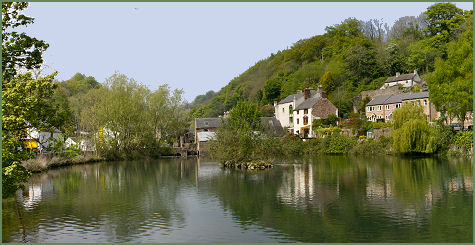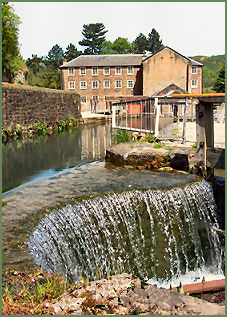Cromford
OS Grid ref:- SK294570
 The Peak District vilage of Cromford is situated around a mile to the south of Matlock Bath. The name derives from a ford over the River Derwent. The village is set in a valley, surrounded by wooded hills and cliffs, bordered by the River Derwent to the east.
The Peak District vilage of Cromford is situated around a mile to the south of Matlock Bath. The name derives from a ford over the River Derwent. The village is set in a valley, surrounded by wooded hills and cliffs, bordered by the River Derwent to the east.
Cromford holds the distinction of being one of the significant sites in the development of the Industrial Revolution. The entrepreneur Richard Arkwright built his cotton mill at Cromford to make use of the Water Frame. In the late eighteenth century, the Gell family, local landowners heavily involved in the nearby Wirksworth lead mining, built the Via Gellia to connect Cromford and Grangemill. Some of the cottages and farm buildings in the village date from before Arkwright's time, but the majority of the buildings were built to provide homes for the mill workers, who were also provided with shops, pubs, chapels and a school, as Arkwright had insisted that children who came to work in the mill could read and write.
 The Cromford Mill buildings (pictured right), erected in 1771 and accommodation for workers to staff the factories form part of the Derwent Valley Mills, which is recognised as a World Heritage Site for its importance. The mill was restored by the Arkwright society which purchased the site in 1979 and is open daily, it attracts visitors from all over the world. It has a visitors centre, shops and a cafe.
The Cromford Mill buildings (pictured right), erected in 1771 and accommodation for workers to staff the factories form part of the Derwent Valley Mills, which is recognised as a World Heritage Site for its importance. The mill was restored by the Arkwright society which purchased the site in 1979 and is open daily, it attracts visitors from all over the world. It has a visitors centre, shops and a cafe.
The Masson Mill (1783) with its unusual convex weir, stands on the northern edge of the village. The mill houses a collection of historic working textile machinery producing yarn and cloth. Masson Mills Shopping Village hosts sixty different retail concepts set over five floors, all under one roof. In December 2001 a 15-mile corridor from Masson Mill in Matlock Bath to the Silk Mill in Derby and including the mills in Cromford, Milford, Belper and Darley Abbey was declared the Derwent Valley Mills World Heritage Site.
 Sir Richard Arkwright lived at Rock House in Cromford, opposite his original mill, but in 1788 he purchased an estate from Florence Nightingale’s father, William for £20,000 and started building Willersley Castle. Sadly, just as the building was completed it was destroyed by fire, and Arkwright had to wait a further two years before it was rebuilt. He died on 3rd August 1792, aged 60, never having lived in the castle which was only completed after his death. Willersley Castle, a Grade II listed building, stands in 60 acres of grounds ranging from meadows to limestone crags and now serves as a luxury hotel.
Sir Richard Arkwright lived at Rock House in Cromford, opposite his original mill, but in 1788 he purchased an estate from Florence Nightingale’s father, William for £20,000 and started building Willersley Castle. Sadly, just as the building was completed it was destroyed by fire, and Arkwright had to wait a further two years before it was rebuilt. He died on 3rd August 1792, aged 60, never having lived in the castle which was only completed after his death. Willersley Castle, a Grade II listed building, stands in 60 acres of grounds ranging from meadows to limestone crags and now serves as a luxury hotel.
The large mill pond (above left) is a highly attractive feature, it has a constantly rotating water-wheel from where Arkwright channelled water to power his mill. The imposing Greyhound Hotel was built in 1788 by Richard Arkwright for the use of businessmen and others visiting the mills. It boasts a magnificent original Georgian frontage.
Awkwright was also responsible for the building of the Canal Wharf and the Cromford Canal, although it too was only completed after his death. The canal ran for 14 miles to join the Erewash Canal at Langley Mill. It has now been restored by the Cromford Canal Society and the Derbyshire County Council, the Cromford section of the canal has a picnic area , visitor centre and car park. The towpath from Ambergate to Cromford is now a very popular walking route, with the Derwent Valley Line adjacent, Leawood Pump House and the High Peak Junction of the Cromford and High Peak Railway.
St Marys church which is situated below the mill dates back to 1797 and contains Arkwrights tomb. The Almshouses date back to 1662 and were founded in accordance with the will of Mary Talbot, the Lady Armine, who left money and land for bede houses for six poor and elderly widows and widowers. A stone coat-of-arms is still visible on the side of the building.
'Celebrating Cromford', a weekend festival celebrating the village and the talents of the people who live here, started in June 2005 and has now become an annual event
Nearby places of interest
Lea Gardens are situated near the town of Matlock. The garden nestles in a south west facing slope at an height of 700 feet above sea level on the northern edge of the Amber Valley, with scenic views of the Peak District hills beyond.
Lumsdale Valley, above the town of Matlock, is a thickly wooded gorge of outstanding natural beauty and a very interesting history, with stone ruins, waterwheels, ponds and waterfalls.
Chatsworth House known as "The Palace of the Peak" is the country seat of the Duke of Devonshire and is situated on the banks of the River Derwent, 3.5 miles to the northeast of Bakewell in the heart of the Peak District National Park.
Dovedale a dramatic limestone ravine, with its impressive rock outcrops and tranquil woodlands is arguably the prettiest and most famous of the dales in the Peak District National Park
